- A day by day account, with pictures, of my Kutch trip. It included visits to villages and Rann of Kutch. Best time is November to February. Kutch is a shopper’s paradise for women.
Thanks to a friend’s friend & neighbour, the Kutch trip happened. Another friend introduced to a taxi owner. Best time to visit-November to February. Here is day wise program -
Day 1
Train reached Bhuj about 7.30 am. I checked
into hotel Swagat. Nice, clean, functional with excellent location Rs 750/ per
day non a/c. Call Chintan 91 81414 74999. Rate in February 2018. After bath I had
poha/tea (available below hotel), left for Bhuj sightseeing. For intra city
travel used auto rickshaw. Early evening I went to local farm to see drip
irrigation.
Day 2 visited a local NGO Shrujan in village Bhujodi (8 kms away) Returned by 5 pm.
Day 3
Left at 7.30 am for Tent City Dhordo. Enroute
stopped by at village Nikona and Shaam-E-Sarhad at Hodko (tents). By evening
reached BSF camp where was staying. Early evening saw BSF Camel Performance and
visited Salt Desert.
Day 4
Early morning visited salt desert. Left for
Khavda where met a BSF officer who escorted us to the Rann of Kutch and Hanuman
Mandir. Evening went to Kalo Dunger.
Day 5
Village visits for handicrafts, Abdul
Pottery at Khavda & Ludiya Gandhi Nu Gam. Evening at Salt Desert. Enroute
visited hotel run by Panchayat. Next was Tent City. Night at Dhordo.
Day 6
Left BSF camp about 9 am, stopped at
Haji Pir, Chhari Dhandh Bird Sanctuary, lunch at Nakhatrana, Fossil Museum, Mata
Na Madh to reach Lakhpat by 4 pm. Saw Lakhpat Fort and Gurdwara i.e. inside
fort. Night at Gurdwara.
Day 7 started with village visit and then to Koteshwar Shiv Temple and Narayan Sarovar. Night was at temple guest house. Nice.
Day 8 Drove to Mandvi. First stop Vijay Vilas Palace, thali lunch at Osho and then beach, ship-building. Night at Bhuj.
Day 9 Drove to Mundra. Enroute Kheda Shiv Temple. Also visited village, saw Step-well and new Shiv/Jain temples. Night at Bhuj.
Day 10 Visited Museum at Bhujodi and met friends. Happy returned by night train.
Swagat
Hotel and driver Meet made trip comfortable. There are lots
of places to eat close to Swagat. I visited in February 2018. Nights cold. For
a senior & super guide call Pramod Jethi 91 93742 35379. For car hire call
Narendra Bhai 91 9925440072 or Meet Bhai 91 88661 94748 or 87803 77140 whom I
used.
You can pick the places you wish to
visit. Now, day-wise details with album links.
Day 1 Bhuj
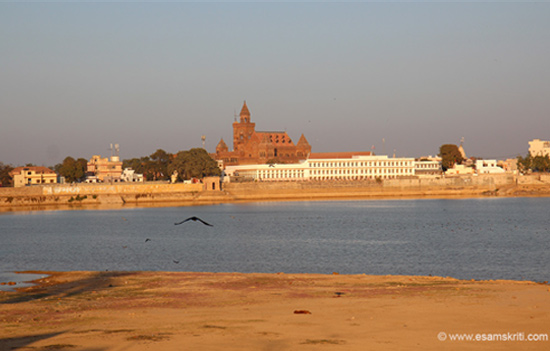 View of Prag Mahal against the setting sun. Pic taken from Hamirsar Talao.
View of Prag Mahal against the setting sun. Pic taken from Hamirsar Talao.
Bhuj was the capital of the Jadeja
dynasty and established in 1510. The walled city of Bhuj was the administrative
and commercial headquarter of the princely state of Kutch. Darbagarh was built
by Rao Shri Khengarji in 1540 and developed into a palace complex over the next
300 years. Prag Mahal is part of this complex.
Prag Mahal was commissioned by King Pragmalji in the 1860's and is designed in the Italian Gothic style. Big bang clock tower is 150 feet high from where you get a great view of Bhuj.
People of Bhuj believe the constant
movement of the snake causes earthquakes in the region. The last major one was
in 2001, before that 1809.
In Bhuj see Prag and Aina Mahals, Royal
Chhatirs, Kutch Museum and Ram Kund step-well. All close by. Prag and Aina are
part of the same complex. Also see Fuvarna Mahal i.e. a great concept. It was
an entertainment room. King sat in centre on marble throne with musicians next
to him. The small island was surrounded by a water filled moat and fountains to
keep place cool. Lamps would be filled up with coloured water, with a layer of
oil and wick on top. Imagine the atmosphere. Also, visit the Museum and
Textiles Market.
Album Prag Mahal
 Durbar Hall in Prag Mahal.
Durbar Hall in Prag Mahal.
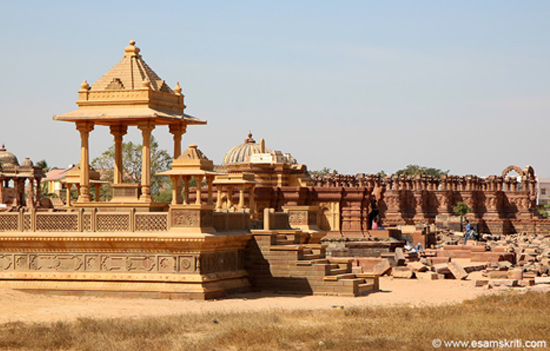 Chhatris of the rulers of Kutch.
Chhatris of the rulers of Kutch.
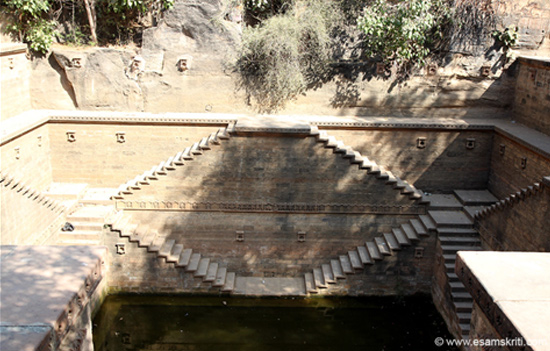 Ram Kund is minutes away from the museum.
Ram Kund is minutes away from the museum.
 Drip irrigation at farm about an hour drive from Bhuj.
Drip irrigation at farm about an hour drive from Bhuj.
Day 2 Shrujan
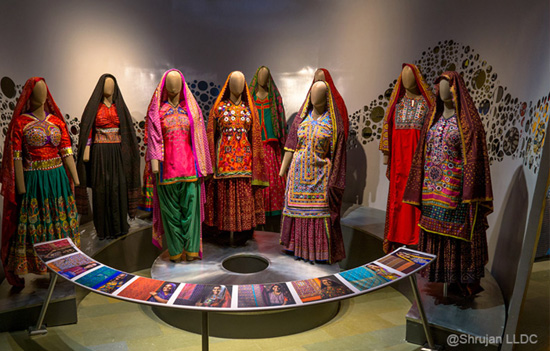 Pic shows dress of various communities in Kutch.
Pic shows dress of various communities in Kutch.
Left to right is Ahir embroidery. In
back row is Rabaari, Sodha,
Meghwaad Maaru, Jat Garaasiya, Jat Fakiraani, Raau Node. In front is Mutva, Meghwaad
Maarwaada, Haalepotra.
In the summer of 1969 Kutch faced a drought
for the fourth year in a row. Smt Chanda Shroff visited Dhaneti village in
Kutch to start a free canteen. Village women were reluctant to accept charity.
In the exquisite embroidery on their clothing Chanda Kaki saw a way for them to
earn a dignified and sustainable livelihood.
Thus, Shrujan took birth. SHRUJAN
(meaning creativity in Sanskrit), is a not for profit NGO that works for craft
revival and sustainable livelihoods of women in Kutch. Shrujan works with over
3,500 women all over Kutch. They are known for embroidery work.
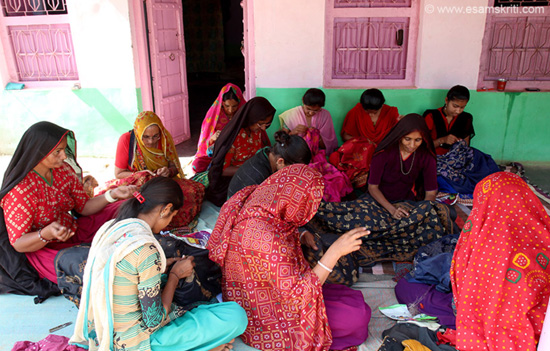 Ladies of village Nironha, about 40 kms from Bhuj, associated with Shrujan.
Ladies of village Nironha, about 40 kms from Bhuj, associated with Shrujan.
I spent the morning at their Living and
Learning Design Centre (LLDC). Over the years Shrujan has expanded to include
research & documentation of the diverse embroideries of Kutch and the
communities thereon. LLDC is a place for preserving, promoting, celebrating
crafts & a training centre for those who wish to acquire or enhance their
skills. Walls are thick so keep heat away.
Area has arid vegetation around and gets
very hot. Thus, the LLDC building is designed to keep the building cool. It is
designed in a manner to let light come in but not hurt. In February 2018 a
gallery, library & three craft studios were operational. A Craft School is
planned. Album sequence is unique building design, museum, shop items for sale
interspersed with village lady pics where Shrujan gets its embroidery work
done.
We also visited village CHEER i.e.
enroute from Lakhpat to Narayan Sarovar. 170 ladies are associated with
Shrujan. Men are employed in power plant close by.
Album SHRUJAN
Close to Shrujan LLDC in Ajrakpur is
workshop of well-known block printer Sufiyan Ismal Khatri, sufiankhatri@yahoo.com
Day 3 Dhordo/Salt Desert/Tent
City
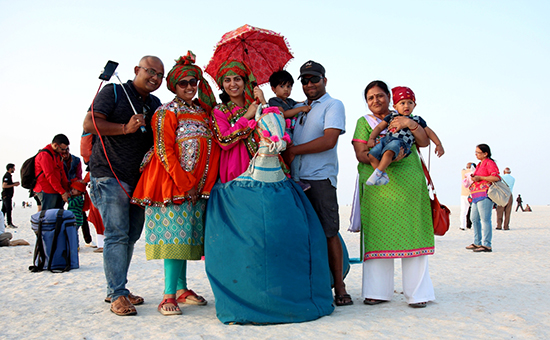 Family at Salt Desert. Locals play dholak.
Family at Salt Desert. Locals play dholak.
During Kutch trip visited villages where
women are associated with Shrujan. First village was Nironha. These ladies do
embroidery work. If a lady works for 30 days in a month and eight hours a day
she would earn app Rs 4,200/.
Bhuj to Dhordo is 81 kms. From Dhordo
drive another 5 odd kms to reach Salt Desert. It has a high altitude Viewing
Point. Rann Utsav is held at Dhordo between November and February (check site
for actual dates).
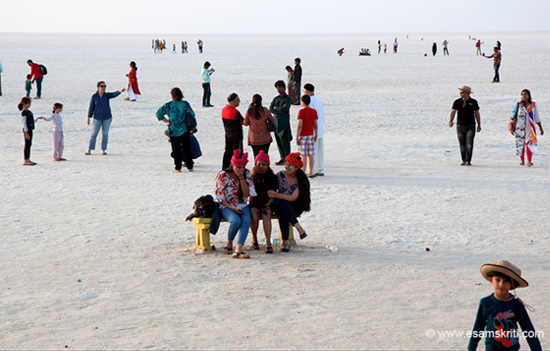 Tourists
at Salt Desert.
Tourists
at Salt Desert.
During season i.e. Nov to Feb end the
BSF (Border Security Force), who guard the area perform a nearly one hour skit
on Saturday and Sunday.
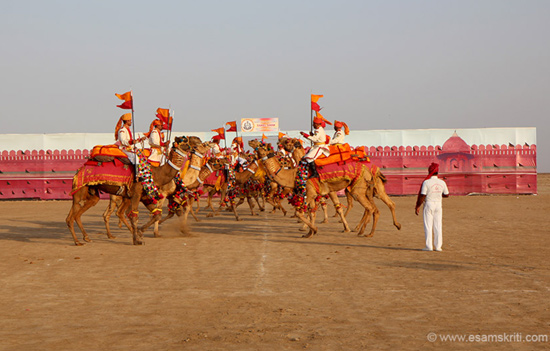 BSF performance close to Salt Desert.
BSF performance close to Salt Desert.
Saw lovely sky colours in evening. Wish
had gone at 5 pm and at noon to see how the colour changes during the day. Early
morning is cold. If lucky you will experience clear skies.
9 Salt
Desert is like a huge football field.
Tent City has superb tents, catering to
various price points. Then had a 3 day 2 night package whereby you see are
shown Salt Desert, Kalo Dhunger and around. Lots of villagers put up shops
selling local handicrafts. Evening there is a musical program. Meals in the dining
hall.
 Overview of VIP Tents area.
Overview of VIP Tents area.
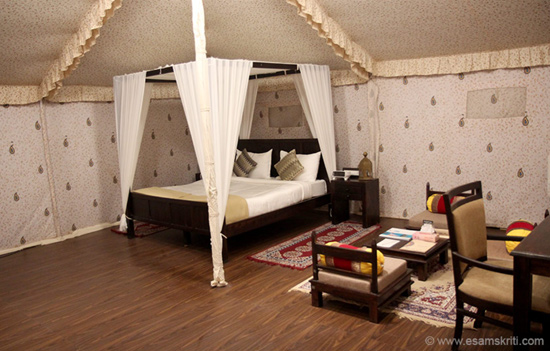 Inside Tent.
Inside Tent.
Outside Tent City is a place i.e.
managed by the village panchayat. “Each room is a stand-alone bhunga, the traditional Kutchi mud hut with thatched roof and decorative hand-painted motifs. Everything here is a shade of brown—the land, the huts, the thatch. These paintings jump out at you with their bright reds, greens, blues and whites. Most bhungas have inlaid glasswork on the walls or within the paintings”. Their site
Besides Tent City is the White Rann Resort. Both were built by the Gujarat
government and then given out to private parties to manage.
Shaam-E-Sarhad at Hodko (before Tent
City) attracts tourists. They have cultural programs in evening. To book online
www.hodka.in,
email hodka.in@gmail.com
Album Salt
Desert and Album Tent City,
Dhordo For some nice
and different type of pictures
Day 4 Rann of Kutch/Kalo
Dhunger
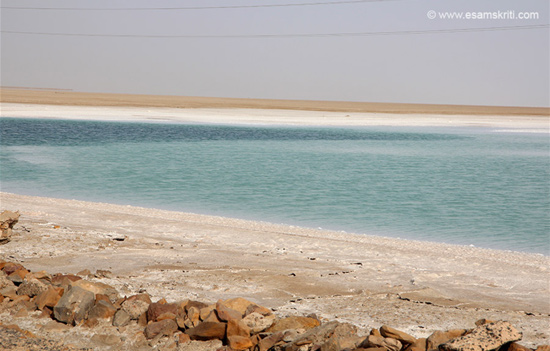 Picture of terrain somewhere near Hanuman Mandir. Note colour of water,
salt and sand.
Picture of terrain somewhere near Hanuman Mandir. Note colour of water,
salt and sand.
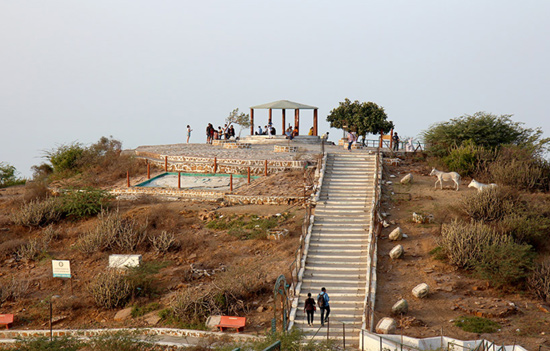 25 kms from Khavda, i.e. about 45 minute drive from Dhordo, the top of the Black Hills is the highest point in Kutch, Kalo Dungar at 462m. From here the entire northern horizon vanishes into the Great Rann, difficult to distinguish between the desert and sky.
25 kms from Khavda, i.e. about 45 minute drive from Dhordo, the top of the Black Hills is the highest point in Kutch, Kalo Dungar at 462m. From here the entire northern horizon vanishes into the Great Rann, difficult to distinguish between the desert and sky.
Hanumanji at Bediya Bet (In Kutch raised
part of land is called BET). Here is story.
 Hanumanji Mandir.
Hanumanji Mandir.
The area in Pakistan opposite where the
current temple exists is called Jat Talai.
It is here that the original Hanuman temple existed. This area was part of
India before 1965 war. Subsequently India agreed to vacate the Jat Talai area.
According to local folklore when troops started moving from that place there
was a message from Hanumanji that why are you leaving me behind, take me with
you. So jawans carried the murti and walked for about 27 kms. They spent the
night at Bediya Bet. Next morning the murthi stuck itself firmly to the ground
and could not be budged. A temple that you see was built there.
Kalo Dungar is 90 kms from Bhuj. It has
a 400 year old temple of Lord Dattatreya, the three headed incarnation of
Brahma, Vishnu and Shiva. According to tradition when Lord Dattatreya walked on
the earth, he stopped at the Black Hills and found a band of starving jackals.
Because of this, temple priests prepared a batch of Prasad i.e. fed to the
jackals after the morning and evening aarti.
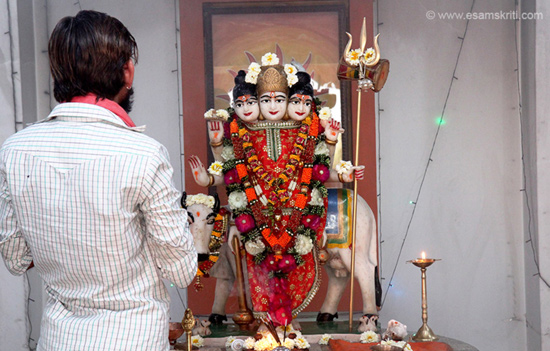 Pranams to Dattatreya. From here Sunrise and Sunset are worth seeing.
Pranams to Dattatreya. From here Sunrise and Sunset are worth seeing.
16 Viewing
point. On a clear day get sunset view but we were not lucky.
Album Kalo
Dunger, Rann of Kutch and village handicrafts
Day 5 Villages/Tent City
Rann Utsav
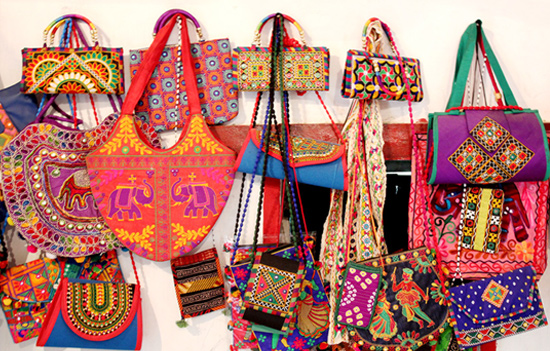 Bags at Meghwal home in village Dhrobana.
Bags at Meghwal home in village Dhrobana.
Next morning visited villages near
Khavda. Village is Dhrobana on Kada Dungar Road. Bags, patch works, kutch
handicrafts, textile embroidery. Call Narsing Bhai Sanjot 91 99133 95481 or
Deva Bhai Sanjot 91 87583 54016. Very good products.
In Bhuj a friend told me to visit Abdul’s pottery shop at Khavda i.e. less than an hour’s drive from Tent City. Khavda is a small town close to the Rann of Kutch.
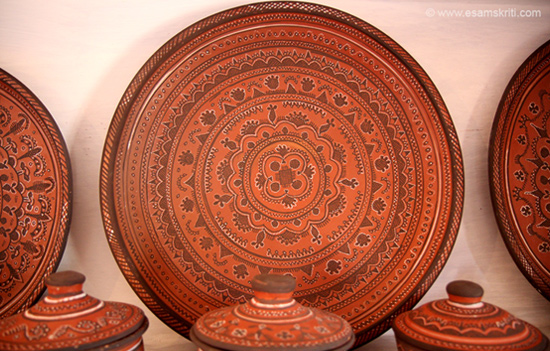 Pottery products for sale.
Pottery products for sale.
Village Ludiya Gandhi Nu Gam near Khavda. Had lunch at home of Puna Sumar Marvada. Outer walls painted with mud colour motifs by women of the house every year during Diwali. “Cylindrical shaped mud walls helps protecting from direct sunrays and hence keep the home cool from inside in the summer. And the cow dung helps resisting the cold during winters.” Their home is called Bhunga. British gave these talented people title of Scheduled Caste.
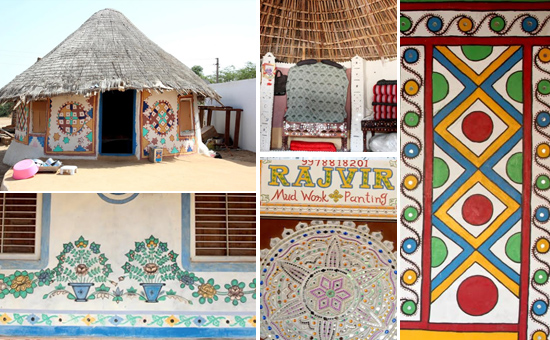 Left pic is typical home called Bhunga with wall paintings.
Left pic is typical home called Bhunga with wall paintings.
“These
traditional bhunga always acts as an arch against the forces applied from any
direction during the earthquake. Since they are in the circular shape, they are
more stable in earthquake situation. Circular shape also helps by not obstructing the wind movement & hence they do not create big pressure and helps during cyclones.”
Album Abdul
Pottery, Album Craft Villages Kutch and Album Mud
Paintings on Bhungas
To read a good
blog on bhunga
Day 6 Fossil Museum, Chhari Dhandh Bird Sanctuary,
Mata Na Madh, Lakhpat Fort
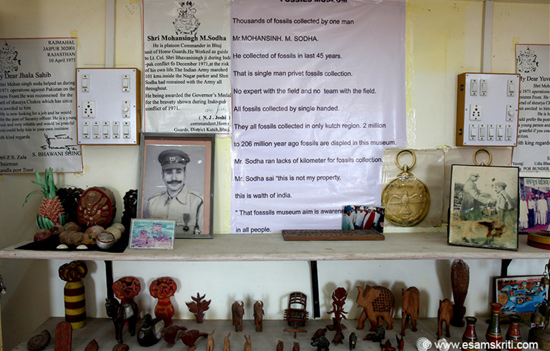 Fossil Museum
Fossil Museum
This is the personal collection of Shri Mohansingh M Sodha. He collected over 45 years by walking himself. Museum is in one big room. There is a caretaker. If you want insights call the Sodha’s that you are coming. Call 91 9725339185 or mail kutchfossil2@gmail.com.
They run a home stay since it is close to the Chari Dhand Wetland Bird
sanctuary. The sanctuary is a huge expanse of water.
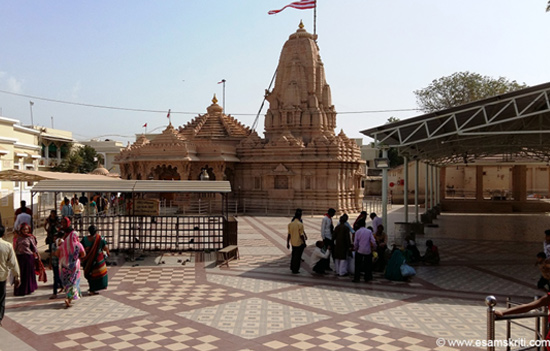 Mata Na Madh.
Mata Na Madh.
Mata Na Madh dedicated to Maa Ashapura. “The temple was built in 14th century by two Karad Vanias, Ajo and Anagor. They were ministers in court of the father of Lakho Fulani.” Earthquake in 1819 and 2001 damaged the temple. It was rebuilt. You see a mosque as soon you walk out of the temple meaning on the road.
At the northwest corner of Kutch, facing
north across the Great Rann towards Pakistan is Lakhpat Fort.
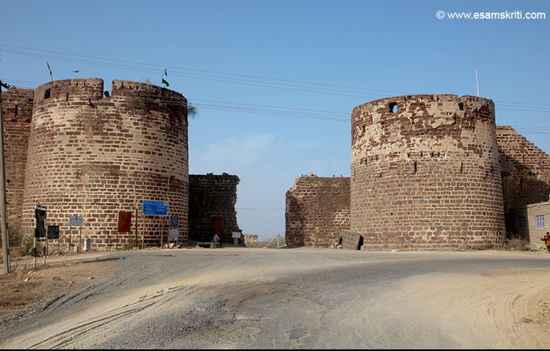 Entrance to Lakhpat Fort.
Entrance to Lakhpat Fort.
It is a huge fort. Within the fort is a
Gurudwara. It is believed that Guru Nanak Dev stayed here enroute on Mecca. The
fort wall was made by Rao Lakhpatji in the 18th century. Fateh M expanded it to
its current dimensions in 1801.
From Lakhpat Guru Nanak crossed to
Somiani port in Sindh and then headed to Mecca. He stayed here during his
second and fourth journeys (udasis) in 1506-1413 and 1519-1521. Gurudwara has 'Charan
Paduka Khadavas-wooden footwear of Guru Nanak.
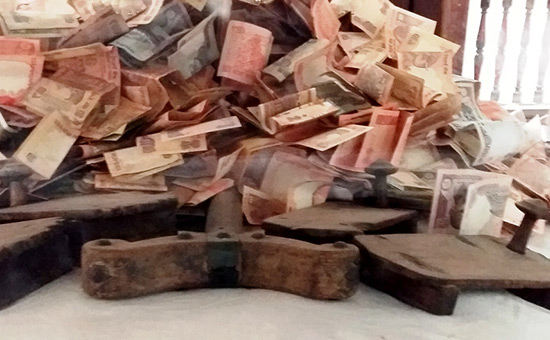 Wooden
footwear of Guru Nanak.
Wooden
footwear of Guru Nanak.
The fort has ruins of Customs House,
Palace, Temple. (see album). Next to fort wall is the Great Rann of Kutch. Till
the earthquake of 1809, the Indus River flowed till Lakhpat.
Album Lakhpat
Fort and Album Lakhpat
Gurudwara
Day 7 Village, Koteshwar
Shiv Temple and Narayan Sarovar
We drove in from Lakhpat to reach about
12 noon. The distance from Bhuj to Narayan Sarovar is 152 kms. It is one of the
5 holy lakes the others being Mansrovar (Tibet), Pampa (Karnataka), Pushkar
(Rajasthan) and Bhuvaneshwar (Orissa).
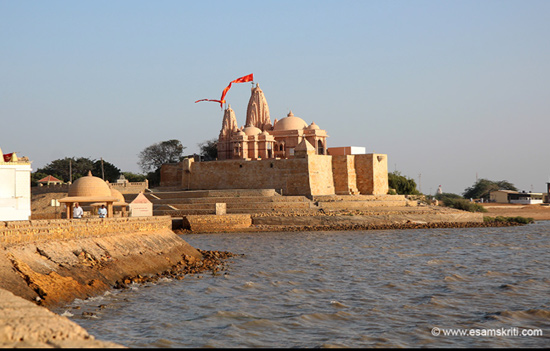 Koteshwar Shiv Mandir.
Koteshwar Shiv Mandir.
Koteshwar is the western most point of
India. It is the place where the sun sets last in India. Kot means fort. It is
situated in the Kori creek. The tide changes here every six hours. When it is
high tide looks like a sea. During low tide you will think it is marshy land.
The Koteshwar story is about Ravana and
Shivji. According to Chinese traveller Hiuen-Tsang Koteshwar port was 5 miles
in boundary near the mouth of the river Indus. There were about 80 Monasteries
with monks. In the middle of the monasteries were 13 temples of which Mahesh
Mandir now Koteshwar was the biggest one.
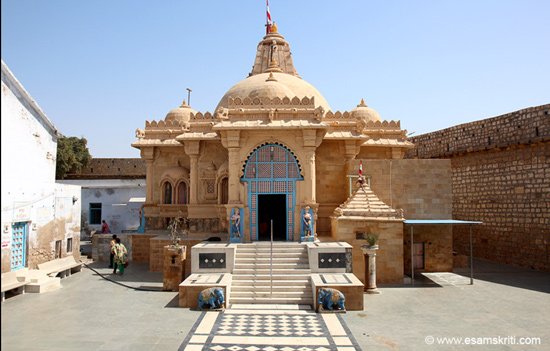 This is Dwarkadhish temple built by Maharani Mankuvar Rajba of Kutch in 1790.
This is Dwarkadhish temple built by Maharani Mankuvar Rajba of Kutch in 1790.
When she visited Dwarkadhish temple at
Dwarka she had an unpleasant experience with the Pujari or priest so she decide
to build a Dwarkadhish temple at Narayan Sarovar.
The Maharani also built four other
temples and a fort surrounding them. The Vaishnav
temples are Shri Trikamraiji, Laxminarayan, Govardhannathji, Dwarkanath,
Adinarayan, Ranchodraiji and Laxmiji. Queen of Rao Deshalji II of Kutch had
built these temples.
I stayed at the temple
guest house, clean and reasonable. The temple kitchen serves prasad (meals) for
free. There is a Gujarat Tourism hotel too.
Album Koteshwar
Shiv Mandir and album Narayan
Sarovar
Day 8 Mandvi Beach, Vijay
Vilas Palace
Mandvi is 60 kms from Bhuj. We drove in
from Narayan Sarovar. Left at 8.30 am and reached before 11. We first went to
Vijay Vilas Palace that was the summer retreat of the Maharaja of Kutch and
reached beach at 12.30. It was hot. Next had lunch at OSHO in the old city.
Awesome thali for Rs 130/. After that met Dr Pulin Vassa, an archaeologist who
has some fascinating discoveries on the area. Went to buy local textiles from
Vivekananda Development Institute and returned to the beach at 5.30 pm to
click.
Mandvi was an ancient port from where ships sailed to Africa and Arabia. “Vessels would take fine cotton, alum, grains and sugar from Mandvi port to Zanzibar and Arabia and have treasures of dates, timber, hides and silks on their return.” “The sea going trading of the Kutchi people explains why region has 5 ports i.e. Mandvi, Mundra, Jakhau, Lakhpat & Koteshwar.”
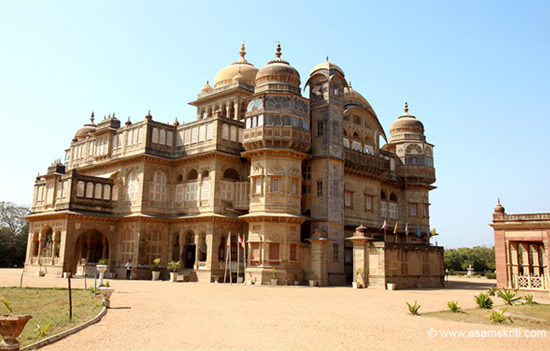 Vijay Vilas Palace.
Vijay Vilas Palace.
Well maintained. Tourists can enter. It was built for Maharao Vijayrajji in 1929. Centre is central dome. It is an “eclectic blend of architectural styles. Umbrella-domes like those seen in palaces of Bengal, cupolas that would not look out of place in Mughal buildings, jarokhas and cusp-arches like those seen in Rajput palaces of Rajasthan, Victorian Gothic arches and classical columns make up the ensemble.” It has a 2 kms private beach.
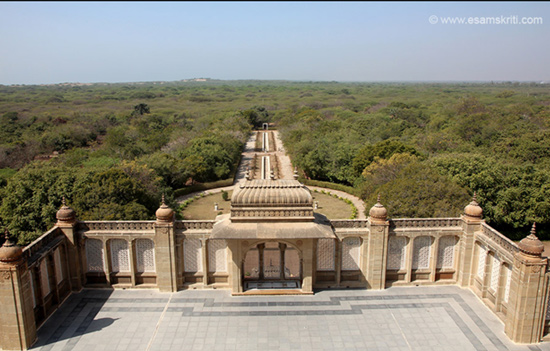 View from second floor.
View from second floor.
 This is what Mandvi beach does to you-lifts up your spirits.
This is what Mandvi beach does to you-lifts up your spirits.
In between saw local ship building activity. “Mandvi was established by Rao Khengarji in 1585. At one time it was a famous harbour connected to South Africa, China, Malaysia, Japan. Navigators of Mandvi were famous all across the world.”
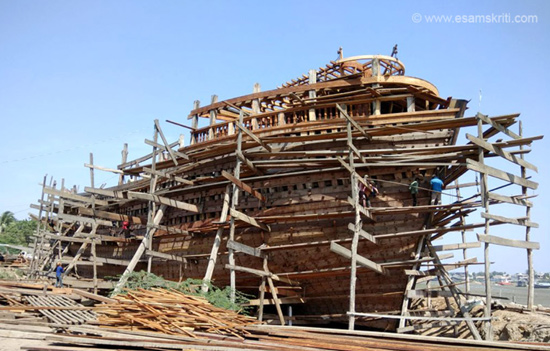 Local ship building. Boats are made from sal wood.
Local ship building. Boats are made from sal wood.
“In the 18th century the ship
building skill developed to an extent that a shipyard to anchor and repairs 400
vessels was established during the reign of Rao Godji. Rukhmati river is where
the river meets the ocean. On river banks is where ships are built. To read more
about shipbuilding at Mandvi
Mandvi Fort is 8 kms long. It was built
by in 1549 by Rashori Bharmalji. In Patan,
Vadnagar, Bhuj saw similar city walls.
The Vivekanand Rural Development
Institute (VRTI) makes and sells shawls, salwar suits, saris, bed sheets, bags
etc. Bought salwars for my wife, she loved them. Contact 02834 230651 & vgsbatik@rediffmail.com.
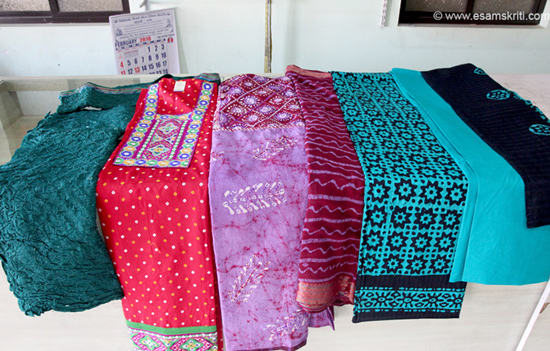 Salwars on display. Bed sheets bought very good.
Salwars on display. Bed sheets bought very good.
Albums Vijay Vilas
Palace and Mandvi Beach.
Read Dhow making in
Mandvi
Day 9 Mundra Village, Shiv
and Jain temples
Enroute visited Khera Shiv Temple ruins.
On reaching Mundra first went to a village where women are associated with
Shrujan. Next visited a new Shiv Temple, a step-well ruin and Jain Mandir where
we had lunch. Post that drove back to Bhuj.
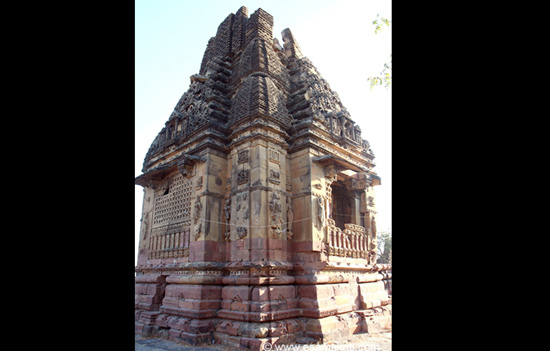 Shiv Mandir, Khera.
Shiv Mandir, Khera.
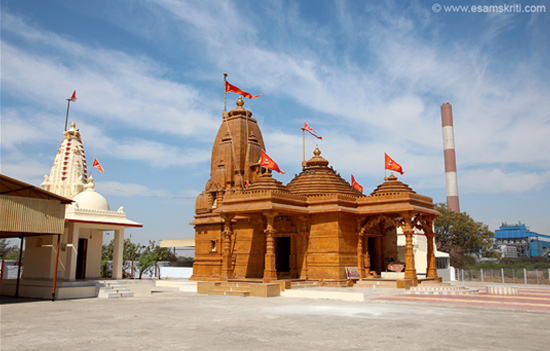 Mahadev Mandir, Mundra. Re-built post 2001 earthquake. Ancient temple was known as Chokhanda Mahadev.
Mahadev Mandir, Mundra. Re-built post 2001 earthquake. Ancient temple was known as Chokhanda Mahadev.
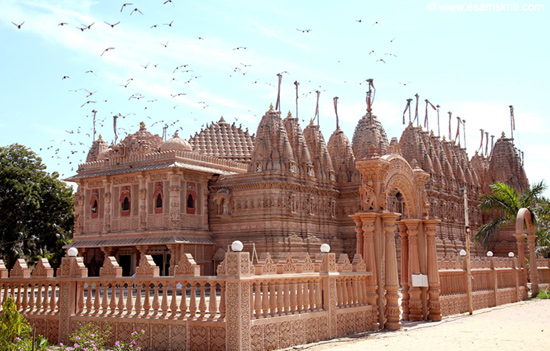 Bhadreshwar Jain Mandir.
Bhadreshwar Jain Mandir.
To see Mundra
album
Day 10 Bhujodi village and return
Bhujodi is a major centre for woven
cotton and woollen textiles, a 500 year old village and 8 kms from Bhuj. They
belong to the very talented and creative Meghwal community, who hail from
Rajasthan.
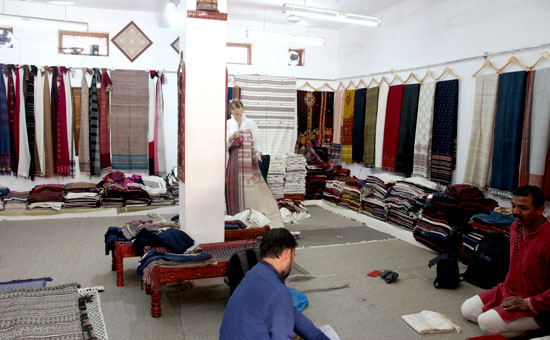 Shamji Bhai Vankar shop in Bhujodi.
Shamji Bhai Vankar shop in Bhujodi.
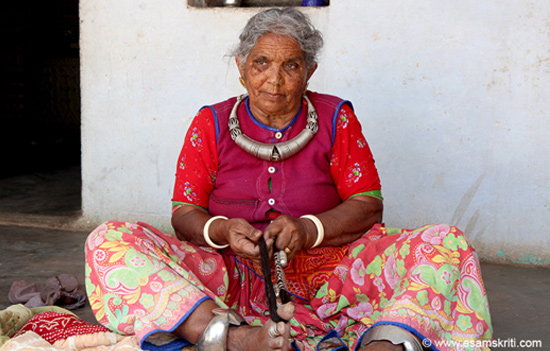 Think she is Shamji’s mother.
Think she is Shamji’s mother.
Album showcases
products sold by three Vankar families and the Shrujan store in Bhujodi.
Also visit the Ashapura Arts and Crafts
Park, Bhujodi to get a quick view of all handicrafts and handlooms. For album It also has a
Parliament House and Red Fort replica that I missed. The village has busts of
Navnitlal Ratanji Shah and Smt Hiralal Shah. Truly, labour of love.
Kutch is waiting to be discovered.
You can cover Gujarat in four parts.
North Gujarat (4 days), Baroda and around (4 days), Kutch 9-10 days, Saurashtra
(7 days)
Also
read
1. The Kutch
Renaissance
2. Shopping in
Kutch
3. To read architects thoughts on
making Shrujan Ajrakhpur
4. How BSF was born
after CRPF defeated Pak Soldiers in Kutch in 1965
To see all albums on Gujarat